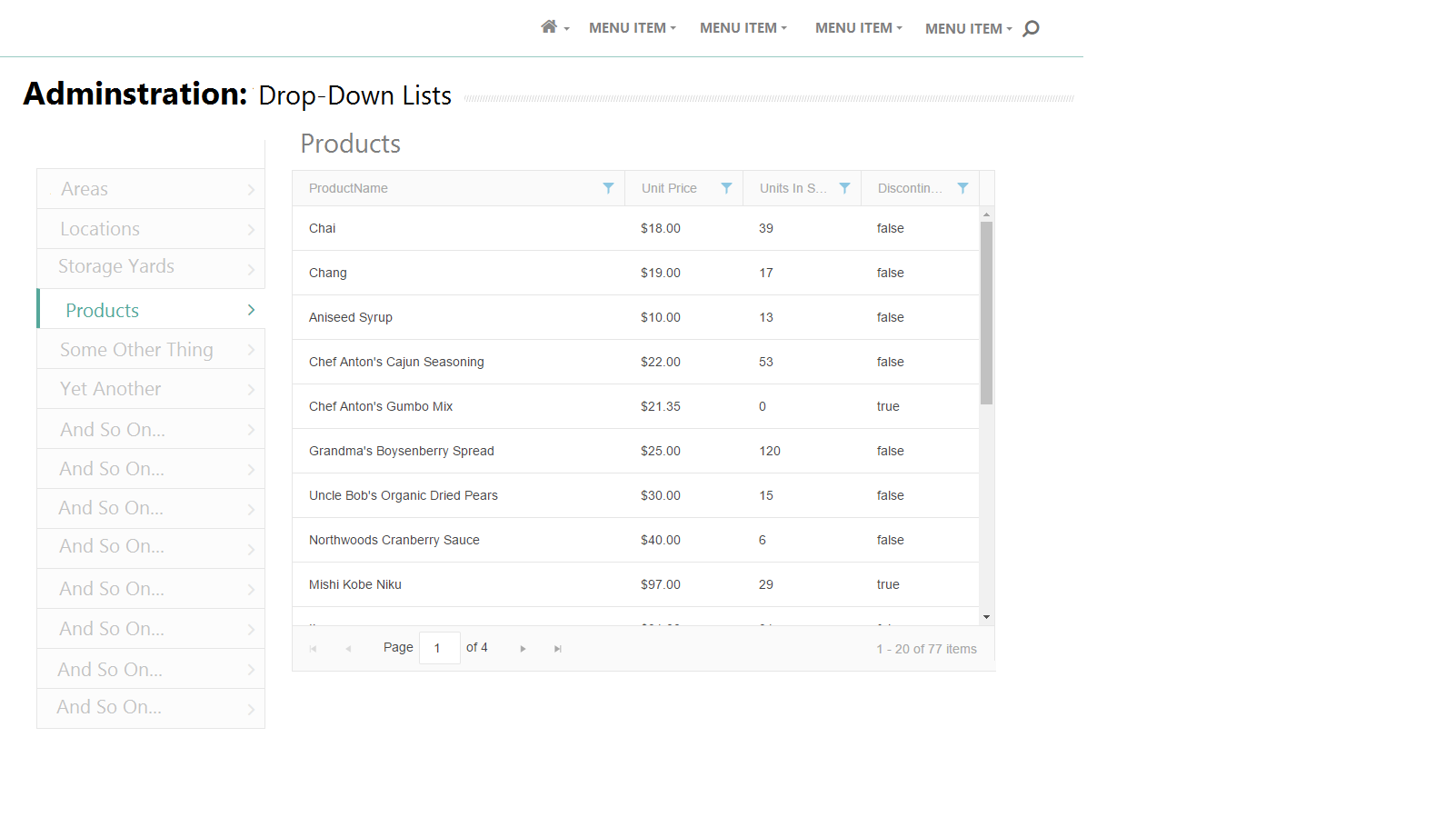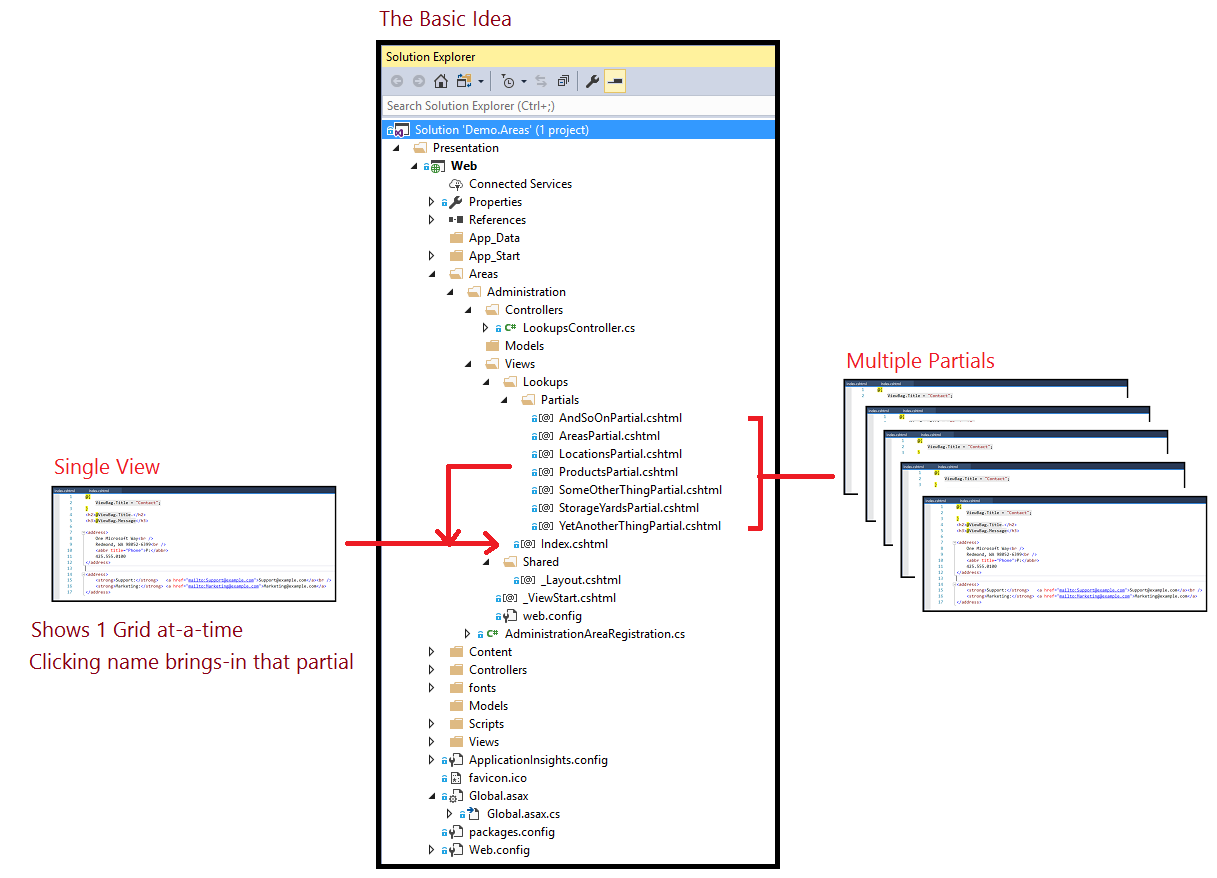我有一个应用程序,其中包含 50 个不同的查找/下拉菜单,管理员需要对其进行管理...并且它必须看起来像下面的初始图像。
我不确定这是否是执行此操作的好方法...但我的一般想法是为每个查找分配一个部分,并在用户单击“查找名称”(左侧)时动态呈现正确的部分。
我在努力避免...
- 创建 50 个不同的 Controller
- 创建 50 个不同的 Action
- 创建 50 个不同的 View
我的问题:
问:如何从单个 View 加载不同的部分?
问:这是解决这个问题的正确方法吗?
问:有更好的方法吗?
屏幕:
屏幕看起来像这样......
控制者:
public class LookupsController : Controller
{
// GET: administration/lookups
[HttpGet]
[AllowAnonymous]
public ActionResult Index()
{
// (1) Simply return the 1st LOOKUP's PARTIAL
// How?
return View();
}
// GET: administration/lookups/{name}
[HttpGet]
[AllowAnonymous]
public ActionResult Index(string name)
{
// (1) If the NAME doesnt map to a LOOKUP PARTIAL = Exception
// How?
return View();
}
}
解决方案:
可能有更好的方法来做到这一点......但这是一般的想法
最佳答案
这是我在概念验证 (POC) 形式中所做的……并且它有效。我会等待将其标记为答案,以防有人想出更好的主意。
在我的特殊情况下,我不需要将 View 模型强类型化到查找的底层实体...因为我在之后调用 Web API渲染。但是,如果它对人们有帮助...我无论如何都会在这里显示 PartialModel 属性。
- 我按原样张贴以防有人需要
- 稍后我会更新 CSS
控制者:
public class LookupsController : Controller
{
// GET: administration/lookups/{name}
[HttpGet]
[AllowAnonymous]
public ActionResult Index(string name)
{
var viewModel = new LookupsIndexViewModel(name);
return View("index", viewModel);
}
}
View 模型:
public class LookupsIndexViewModel
{
#region <Properties>
private const string DEFAULT_PARTIAL_PATH = "~/Areas/Administration/Views/Lookups/Partials/ProductsPartial.cshtml";
#endregion
#region <Properties>
public String PartialRelativePath { get; set; }
public PartialViewModel PartialModel { get; set; }
#endregion
#region <Constructors>
public LookupsIndexViewModel(string name)
{
Init(name);
}
#endregion
#region <Methods>
public void Init(string name)
{
PartialRelativePath = DEFAULT_PARTIAL_PATH;
// TODO: Use a factory here
if (!string.IsNullOrWhiteSpace(name))
SetPartialProperties(name);
}
///<note>You could certainly replace this functionality with a Factory object</note>
private void SetPartialProperties(string name)
{
string root = "~/Areas/Administration/Views/Lookups/Partials/";
switch (name.ToLower())
{
case "andsoon":
PartialRelativePath = root + "AndSoOnPartial.cshtml";
PartialModel = new PartialViewModel();
break;
case "areas":
PartialRelativePath = root + "AreasPartial.cshtml";
PartialModel = new PartialViewModel();
break;
case "locations":
PartialRelativePath = root + "LocationsPartial.cshtml";
PartialModel = new PartialViewModel();
break;
case "products":
PartialRelativePath = root + "ProductsPartial.cshtml";
PartialModel = new PartialViewModel();
break;
case "someotherthing":
PartialRelativePath = root + "SomeOtherThingPartial.cshtml";
PartialModel = new PartialViewModel();
break;
case "storageyards":
PartialRelativePath = root + "StorageYardsPartial.cshtml";
PartialModel = new PartialViewModel();
break;
case "yetanotherthing":
PartialRelativePath = root + "YetAnotherThingPartial.cshtml";
PartialModel = new PartialViewModel();
break;
}
}
#endregion
}
public class PartialViewModel
{
// Your awesome Strongly Typed View Model stuff goes here
}
景观:
@using Web.Areas.Administration.ViewModels
@model LookupsIndexViewModel
<div class="container">
<div class="row">
<div class="col-md-12">
<h1>Lookups Administration</h1>
<h2 id="subTitle"></h2>
</div>
</div>
<div class="row">
<div class="col-md-3">
<!-- Sections Menu-->
<ul class="nav nav-section-menu mb-4 py-3">
<li>
@Html.ActionLink("Areas", "index", "lookups", new { area = "Administration", name = "areas" }, null)
</li>
<li>
@Html.ActionLink("Locations", "index", "lookups", new { area = "Administration", name = "locations" }, null)
</li>
<li>
@Html.ActionLink("Products", "index", "lookups", new { area = "Administration", name = "products" }, null)
</li>
<li>
@Html.ActionLink("Storage Yards", "index", "lookups", new { area = "Administration", name = "storageyards" }, null)
</li>
<li>
@Html.ActionLink("Some Other Thing", "index", "lookups", new { area = "Administration", name = "someotherthing" }, null)
</li>
<li>
@Html.ActionLink("Yet Another Thing", "index", "lookups", new { area = "Administration", name = "yetanotherthing" }, null)
</li>
<li>
@Html.ActionLink("And So On", "index", "lookups", new { area = "Administration", name = "andsoon" }, null)
</li>
</ul>
</div>
<div class="col-md-9">
@Html.Partial(Model.PartialRelativePath, Model.PartialModel)
</div>
</div>
</div>
@section scripts
{
<script type="text/javascript">
$(document).ready(function () {
onReady();
});
</script>
}
每个部分:
<div id="grid"></div>
<script type="text/javascript" defer>
// RESEARCH:
// https://stackoverflow.com/questions/7556400/injecting-content-into-specific-sections-from-a-partial-view-asp-net-mvc-3-with
var onReady = function ()
{
$("#subTitle").text("And So On");
$("#grid").kendoGrid({
dataSource: {
type: "odata",
transport: {
read: "https://demos.telerik.com/kendo-ui/service/Northwind.svc/Customers"
},
pageSize: 20
},
height: 550,
groupable: true,
sortable: true,
pageable: {
refresh: true,
pageSizes: true,
buttonCount: 5
},
columns: [{
template: "<div class='customer-photo'" +
"style='background-image: url(../content/web/Customers/#:data.CustomerID#.jpg);'></div>" +
"<div class='customer-name'>#: ContactName #</div>",
field: "ContactName",
title: "Contact Name",
width: 240
}, {
field: "ContactTitle",
title: "Contact Title"
}, {
field: "CompanyName",
title: "Company Name"
}, {
field: "Country",
width: 150
}]
});
}
</script>
关于c# - 使用 ASP.Net MVC 在单个 View 中管理多个查找,我们在Stack Overflow上找到一个类似的问题: https://stackoverflow.com/questions/44616881/

